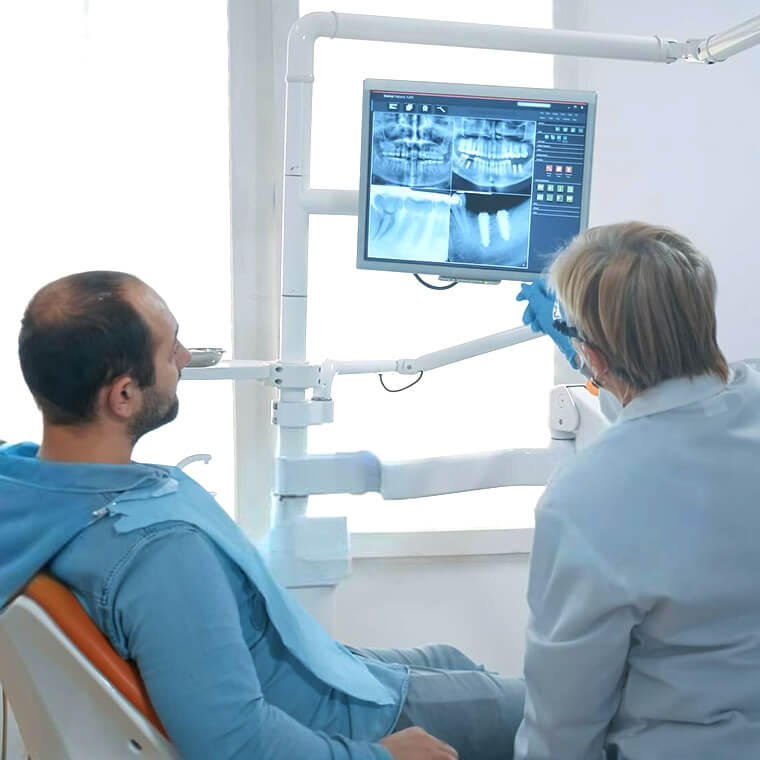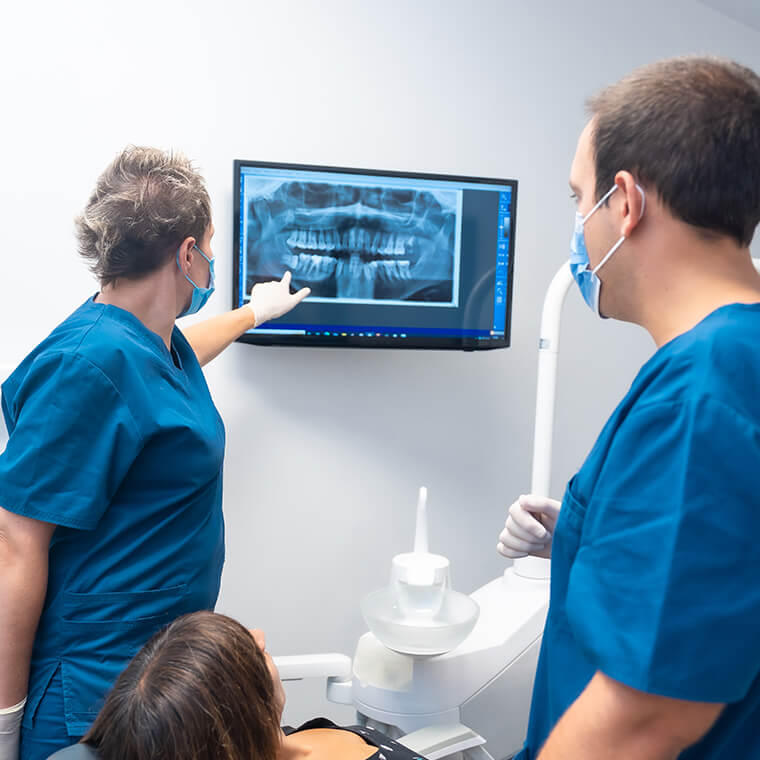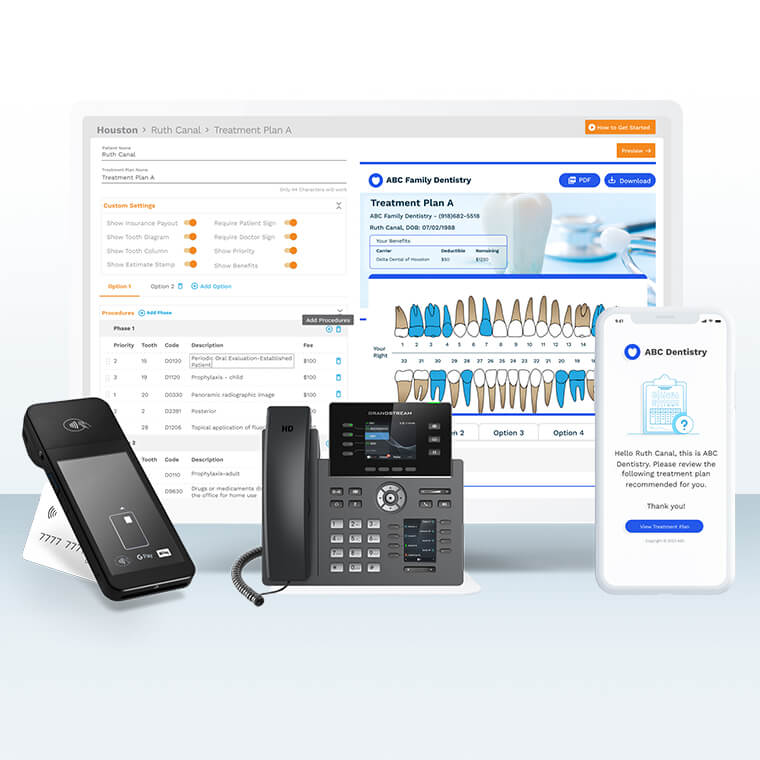Ends in
ends in 106 Days

ends in 106 Days

ends 11 July
From Diagnosis to Treatment: Creating a Seamless Dentist Treatment Plan

Creating a comprehensive dentist treatment plan is essential for improving patient compliance and satisfaction. A successful case presentation not only ensures effective dental care but also provides a cohesive and transparent journey from diagnosis to treatment. However, outdated processes and communication gaps often hinder the creation of smooth treatment experiences.
This guide demonstrates how blending modern dental treatment planning software with traditional oral healthcare practices can bridge these gaps and ensure better patient engagement.
How to Create the Perfect Dental Treatment Plan

A smooth, effective treatment plan is key to providing great dental care. By combining traditional approaches with modern tools, you can ensure patients understand every step and feel confident in their care. Let’s walk through the essential phases of creating a personalized treatment plan that keeps your practice running smoothly and your patients on track.
Phase 1: Diagnosis
A patient-centered dental care plan starts with a thorough and accurate diagnosis. The use of diagnostic tools, combined with treatment planning software, sets the stage for a streamlined process.
- Comprehensive Patient Evaluation: Conduct a detailed examination, including clinical assessments, necessary imaging (X-rays, scans), and a review of the patient’s medical history, medications, allergies, and pre-existing conditions.
- Effective Communication: Engage patients in discussions about symptoms and concerns. Use digital forms to streamline data collection before appointments and encourage patients to provide detailed information.
- Collaborative Diagnosis: Involve specialists when necessary to ensure a multi-disciplinary approach. This might include referrals to orthodontists, periodontists, or oral surgeons to ensure comprehensive care.
- Risk Assessment: Evaluate risk factors like smoking, diabetes, or poor oral hygiene that could impact the success of the treatment. This proactive approach can shape the treatment plan and set realistic expectations.
- Oral Cancer Screening: Include an oral cancer screening in your assessment to catch potential issues early and provide patients with peace of mind.
- Patient Education: Explain findings in simple terms, using visual aids when possible, to ensure patients fully understand their oral health and treatment options.
- Documentation: Record all findings meticulously to ensure a clear reference for future treatment phases and follow-up care.
By using software to streamline the diagnostic phase, dentists can spend more time engaging with patients and less time managing administrative tasks, which leads to more accurate and comprehensive treatment plans.
Phase 2: Treatment Planning

With a diagnosis in hand, the next step is developing a treatment plan tailored to the patient's needs. Dental treatment planning software plays a crucial role here, enabling efficient plan creation and communication.
- Setting Clear Objectives: Define specific, measurable goals for treatment to align patient expectations with realistic outcomes. For example, a patient with gum disease may have goals like reducing inflammation and improving oral hygiene within a set timeframe.
- Presenting Treatment Options: Offer multiple treatment alternatives, explaining the pros and cons of each in simple language. This helps patients make informed decisions about their care.
- Visual Aids: Use digital imaging software or 3D models to show potential results and treatment options, allowing patients to visualize outcomes and feel more confident in their choices.
- Incorporating Patient Preferences: Discuss factors like time, cost, and lifestyle. Tailor the treatment plan to suit the patient’s preferences, ensuring a realistic and manageable path forward.
- Financial Considerations: Integrate financial discussions early by outlining insurance coverage and payment plan options alongside treatment proposals, so patients are fully informed.
- Documentation and Compliance: Use digital treatment planning tools to document all aspects of the plan. Ensure compliance by automating reminders for patient follow-ups, treatment milestones, and financial commitments.
- Treatment Timeline: Establish a clear treatment schedule, including estimated timeframes for each phase of care, so patients know what to expect and how long the process will take.
- Informed Consent: Ensure that the patient fully understands the proposed plan and has had all their questions answered before moving forward. Written consent should be obtained after reviewing the details.
- Interdisciplinary Collaboration: If necessary, coordinate with other specialists to integrate different aspects of care into a unified treatment plan, enhancing both the patient’s experience and outcome.
These features ensure that both the patient and dental team are on the same page, improving communication and reducing misunderstandings.
Phase 3: Financial Planning
One of the biggest barriers to patient compliance is the financial aspect of treatment. Dental software can streamline this process, making financial planning transparent and creating affordable oral healthcare options for patients.
- Insurance Verification: Verify the patient’s insurance benefits before starting treatment to avoid surprises. Use dental verification software to automate this process and provide a clear understanding of coverage.
- Cost Transparency: Provide a detailed breakdown of all costs, including what is covered by insurance and what the patient will be responsible for out-of-pocket. This step ensures patients understand their financial obligations upfront.
- Payment Plan Options: Offer flexible payment plans, such as CareCredit or in-house financing, to make treatments more affordable. Present these options early to help patients plan their payments.
- Financial Documentation: Provide patients with written or digital estimates that detail the costs, payment schedules, and insurance coverage, ensuring they have a reference for their financial responsibilities.
- Discuss Financing Alternatives: Present different financing options, including third-party lenders, and explain how they can ease the patient’s financial burden while ensuring necessary treatments are pursued without delay.
- Explaining Deductibles and Copays: Clearly explain how insurance deductibles and copays will affect the patient’s financial responsibility for each visit or treatment phase.
- Breakdown of Treatment Stages: Divide the overall cost into phases, correlating payments with each stage of treatment. This allows patients to manage costs more easily over time.
- Pre-Treatment Approval: Before treatment begins, secure written approval from the patient regarding the financial plan, ensuring they are fully aware of both the treatment and its associated costs.
- Handling Unexpected Costs: Discuss potential additional costs upfront, such as complications or elective options, so patients are prepared for any financial variations.
- Ongoing Financial Communication: Keep open communication with patients about their financial obligations as treatment progresses, providing regular updates if necessary and addressing any financial concerns.
This phase is crucial in reducing delays, building trust, and increasing the likelihood of patient compliance.
Phase 4: Treatment Execution
Presenting and implementing a dentist treatment plan seamlessly depends on continuous communication and proper scheduling, both of which are made easier with software.
How Petaluma Dental Group replaced 10 software vendors with Adit How many software vendors could your practice replace with Adit? Petaluma Dental Group was stuck managing a patchwork of over 10 software tools. None of them integrated; all of...
Schedule a Demo- Efficient Scheduling: Dental scheduling software helps you coordinate appointments seamlessly, ensuring patients receive timely care without overwhelming your team. Online booking options improve accessibility, allowing patients to manage their schedules more effectively.
- Continuous Communication: Automated SMS and email reminders, integrated within the treatment plan software, ensure patients stay informed and engaged. This improves attendance rates and enhances the patient experience by keeping them in the loop throughout their treatment.
- Patient Follow-Up: After each session, follow-up communication can be automated through the software, allowing dentists to monitor recovery and ensure patient satisfaction. Automated check-ins reduce the manual burden on staff and provide consistent post-treatment care.
With modern tools, patients receive a smoother, more organized treatment experience from start to finish.
Overcoming Challenges in Treatment Planning

Creating a seamless treatment plan isn’t always easy. Dentists often face challenges that can complicate the process, from managing patient expectations to administrative bottlenecks. Tackling these roadblocks head-on is essential for providing top-notch care and keeping patients engaged.
Communication Issues
Misunderstandings between the dental team and patients frequently lead to confusion about treatment steps, goals, and costs. Simplify communication with tools like digital treatment planning software. Sharing visuals such as 3D images can help patients fully grasp their treatment options. Following up with summaries after appointments keeps everything clear and accessible.
Admin Overload
Manual paperwork and scheduling slow down the process and increase the chances of mistakes. Automate! Platforms like Adit dental practice management software streamline scheduling, insurance verification, and even form submission. This frees up time for your staff and ensures accuracy, speeding up the entire process.
Patient Compliance
Patients may struggle to follow through with treatment due to financial concerns, fear of procedures, or not fully understanding the importance of the plan. Educate patients using both in-office explanations and digital resources. Offer flexible payment options like financing plans, and use automated reminders to keep them on track with appointments and care instructions.
Financial Worries
Costs are often the biggest hurdle for patients when deciding on treatment. Be transparent about pricing and offer flexible payment options early on. Leverage tools for automated cost breakdowns and insurance verification to ease patients’ financial concerns. Consider adding a financing integration like CareCredit to help qualifying patients get the dental care they need on terms they can afford.
Time Constraints
Busy schedules can leave little room for thorough treatment planning, often leading to rushed appointments. Maximize time by using automated scheduling systems. Allow patients to schedule appointments online, view their treatment plans, and pay through digital portals, freeing up office staff to focus on patient care.
Complex Cases
Multi-specialist care can make treatment coordination tricky, especially when it involves complex cases. Use integrated treatment planning software that enables easy sharing of diagnostic images and records with specialists. Collaborative tools keep all providers in sync, ensuring nothing gets lost in translation.
By addressing these common challenges with the right solutions, dental practices can create smoother, more efficient treatment planning processes. When technology and communication are in sync, both patients and providers benefit from a more seamless experience.
The Digital Advantage: Enhancing Your Practice with Dental Treatment Planning Tools

Dental treatment planning software is a game changer for creating a seamless, patient-centered experience that benefits your entire clinic. By using advanced practice management solutions like Adit, you can enhance a variety of processes in your dental office to better support your dentist treatment plan process:
- Streamlined Workflow Integration: Your dental treatment software should integrate smoothly with your other practice management tools, whether it’s scheduling or billing. This interconnectedness means that every aspect of patient care, from the first appointment to financial discussions, runs like a well-oiled machine.
- Centralized Records: Imagine having all your EHRs, diagnostic images, and treatment plans automatically uploaded in one easy-to-access spot. This central hub can boost accuracy during consultations and keep your team on the same page, minimizing errors and making workflows more efficient.
- Automated Dental Treatment Plans: Forget the guesswork! Automated treatment plans ensure that every case is handled with consistency. Plus, when adding visual aids, this personalization helps patients understand their options better, making it easier for them to agree to their treatment plans.
- Enhanced Communication Tools: Keep your patients in the loop with integrated SMS text and email reminders. These handy tools reduce no-shows and help ensure patients stick to their treatment schedules. With automated follow-ups, your staff can focus on providing excellent care while staying connected with patients.
- Practice Analytics: Dive into built-in data analytics that tracks patient satisfaction, treatment outcomes, and compliance rates. This information helps identify what’s working and what needs tweaking, refining your treatment planning process, and boosting patient care over time.
- Patient Engagement Features: Equip your patients with educational resources, treatment plan visualizations, and online portals to access their information. By empowering them to take an active role in their care, you foster trust and satisfaction, leading to higher retention rates.
By incorporating dental treatment planning software into your practice, you’re not just simplifying the admin side of things; you’re also enhancing the entire clinic experience. With better communication, improved collaboration among your team, and insights from practice analytics, you can elevate patient outcomes and create a more efficient, patient-friendly environment.
Maximize Case Acceptance with Adit's Complete Dentist Treatment Plan Toolkit

Ready to transform your treatment planning process and enhance patient care? Adit’s comprehensive dental software platform offers 17+ powerful tools designed to streamline operations, enhance communication, and improve patient outcomes.
Why Choose Adit?
- Integrated Treatment Planning: Seamlessly generate and manage treatment plans tailored to your patients' needs, making the process more efficient and patient-friendly.
- Automated Reminders and Communication: Use automated SMS texts, email notifications, and follow-up appointment reminders to keep your patients informed and engaged, reducing no-shows and enhancing compliance with their treatment plans.
- Practice Analytics: Leverage insightful data to track key performance indicators like patient satisfaction, treatment success rates, and workflow efficiency, enabling you to make informed decisions for continuous improvement.
- Streamlined Financial Planning: Simplify billing and insurance processes with tools that handle patient billing, insurance verification, and payment processing, all in one place with Adit Pay.
- Customizable Treatment Plan Templates: Create and store templates for common procedures to save time and ensure consistency in your treatment plans.
- Centralized Patient Records: Access all patient information, from treatment history to diagnostic images, in one easy-to-navigate interface, ensuring you have the complete picture at your fingertips.
- Patient Engagement Tools: Enhance patient involvement with visual aids, educational resources, and treatment plan previews to foster understanding and acceptance.
- Secure Document Sharing: Facilitate seamless communication between staff and patients with secure sharing options for documents, treatment plans, and educational materials.
- Mobile Access: Manage your dental practice on the go with our mobile app for patient records, treatment plans, and communication tools, ensuring you never miss a beat.
- In-House Chat Feature: Improve team collaboration with real-time messaging capabilities, allowing staff to communicate effectively without leaving the software.
- Robust Reporting Tools: Generate detailed reports on a wide range of metrics, such as treatment outcomes and financial performance, to gain insights into your practice's health.
Discover how Adit can help you create a seamless, patient-centered practice that not only meets but exceeds your patients' expectations. Schedule a free demo today to explore how our integrated tools can enhance your dental operations, from diagnosis to treatment and beyond.
more about Adit?
Access a full suite of patient communication tools with Adit! Texting, payments, reviews, & scheduling in one place.
Schedule a DemoAngela is a former English teacher turned marketing content specialist. Over the past 10 years, she’s developed marketing strategies to forge enduring bonds between B2B, B2C and SaaS companies and their clients through holistic education, effective communication, and captivating storytelling that moves audiences to act.
Get a $25 Gift Card when you take a demo
Schedule a Demo
Get a $50 Gift Card
when you take a demo
Looks like you're out of bounds!
Hey there! Your current location falls outside Adit's area of operation. If this is unexpected, try disabling your VPN and refresh your page. For further assistance or to book a live demo, connect with us at 832-225-8865.
December 17 Amazon Demo Promo
Terms and Conditions
Last Updated: December 17, 2025Offer ends December 20, 2025, and is limited to prospective customers who sign an annual agreement before December 31, 2025. Gift card will be emailed to the company owner or established representative within 4 weeks of signing the annual agreement. Offer may not be combined with any other offers and is limited to one (1) gift card per office. Offer is not available to current customers or to prospective customers or individuals that have participated in a Adit demo during the prior six (6) months. Recipient is responsible for all taxes and fees associated with receipt and/or use of the gift card as well as reporting the receipt of the gift card as required under applicable federal and state laws. Adit is not responsible for and will not replace the gift card if it is lost or damaged, is not used within any applicable timeframe, or is misused by the recipient. Adit is not responsible for any injury or damage to persons or property which may be caused, directly or indirectly, in whole or in part, from the recipient’s participation in the promotion or receipt or use of the gift card. Recipient agrees to indemnify, defend and hold harmless Adit from and against any and all claims, expenses, and liabilities (including reasonable attorney’s fees) arising out of or relating to a recipient’s participation in the promotion and/or recipient’s acceptance, use or misuse of the gift card. This offer is sponsored by Adit Communications, Inc. and is in no way sponsored, endorsed or administered by, or associated with Amazon.
Thank You!
We appreciate your interest! Adit AI will be calling you in the next few minutes!
Why Adit?
Cut your software bill by up to 60% when you merge everything your dental office needs to run under one roof.
Centralize Communications
- Phones & TeleMed
- Emails & eFax
- Texting & Reminders
- Call Tracking and more!
Streamline Operations
- Patient Forms
- Online Scheduling
- Payments
- Reviews and more!
Boost Production
- Performance Dashboards
- Morning Huddle
- Claims & Collections
- Patient Profiles
- Follow Up Lists
- Year Over Year Metrics
Acquire More Patients
- Digital Marketing
- Website Design
- SEO
- Google Ads
- Facebook Ads
Ends in

Sign up by filling out the form







